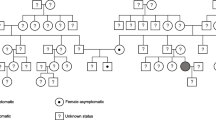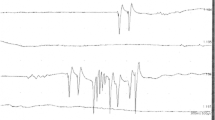Summary
Diminished activity of uroporphyrinogen I-synthetase in the liver and other tissues may be regarded to be the primary genetic deficiency of acute intermittent porphyria (AIP). Increased production and renal excretion of delta-aminolevulinic acid (ALA) und porphobilinogen (PBG) are secondary phenomena. The neuropsychiatric symptomatology of AIP consists of neuropathy, vegetative crises and exogenous psychoses.
In this study electromyographic and neurographic investigations were performed on 20 persons with AIP. 16 patients had experienced attacks of AIP, 10 of them including neuropathy. 4 persons showed the biochemical findings of AIP but had not yet had symptoms.
In cases with persistent pareses following porphyric neuropathy denervation signs or sequelae were still present. In patients without clinical symptoms and in latent cases there were normal or borderline findings. Motor nerve conduction velocity was mostly decreased in combination with denervation signs and in a range that indicated a primarily axonal nerve lesion and consequent myelin damage rather than primary demyelinization. The mean motor conduction velocity of n. tibialis was somewhat lower in patients with porphyric crises without neuropathy than in latent cases without any clinical crises. The differences were not significant in other nerves. The findings are discussed under consideration of the electrodiagnostic results of other investigations and of neuropathological and clinical data.
Zusammenfassung
Bei 20 Patienten mit akuter intermittierender Porphyrie (AIP) wurden elektromyographische und elektroneurographische Untersuchungen durchgeführt. 16 Patienten hatten Krankheitsschübe mit und ohne Polyneuropathie ein- oder mehrmals durchgemacht. 4 Personen hatten bisher keinen klinischen Schub, wiesen aber die typischen biochemischen Befunde der AIP auf.
Bei abgelaufener Neuropathie und in der Kompensationsphase noch bestehenden neurologischen Symptomen waren Denervationsfolgen elektrodiagnostisch feststellbar, bei klinisch unauffälligen und bei latenten Fällen waren Normal- oder Grenzbefunde zu erheben. Die Nervenleitgeschwindigkeit ist meistens in einem Ausmaß verändert, das auf eine primär axonale Schädigung und nicht auf eine primäre Demyelinisation hinweist. Die mittlere (maximale) motorische NLG des Nervus tibialis lag in der Gruppe von Patienten mit Porphyrieschüben ohne Polyneuropathie etwas niedriger als in den latenten Fällen ohne jede klinischen Symptome. In anderen Nerven waren entsprechende Unterschiede nicht signifikant.
Die Befunde werden unter Berücksichtigung elektrodiagnostischer Ergebnisse anderer Untersucher, klinischer und neuropathologischer Befunde diskutiert.
Similar content being viewed by others
References
Buchthal, F., Rosenfalck, A.: Evoked action potentials and conduction velocity in human sensory nerves. Brain Res. 3, 1–122 (1966)
Cavanagh, J. B., Mellick, R. S.: On the nature of the peripheral nerve lesions associated with acute intermittent porphyria. J. Neurol. Neurosurg. Psychiat. 28, 320–327 (1965)
Denny-Brown, D., Sciarra, D.: Changes in the nervous system in acute porphyria. Brain 68, 1 (1945)
Druschky, K.-F., Schaller, K.-H., Kammerer, H.: Die Bestimmung der Uroporphyrinogen I-Synthetase im Vollblut — eine Methode zur Diagnostik und Früherkennung der akuten intermittierenden Porphyrie. Verhandl. Dtsch. Gesellsch. inn. Med. 81, 1459–1462 (1975)
Erbslöh, F.: Neurologische Aspekte der akuten Porphyrie. Dtsch. Ges. Verd.-Stoffw.-Krh., 21. Tag. Hamburg, Gastroenterologia 97, 384–404 (1962)
Garcin, R., Lapresle, J.: Manifestations nerveuses des porphyries. Sem. Hôp. Paris 26, 3404–3423 (1950)
Gibson, J. B., Goldberg, A.: The neuropathology of acute porphyria. J. Pathol. Bacteriol. 71, 495–509 (1956)
Hopf, H. C.: Impulsleitung in peripheren Nerven. In: Hopf, H. C., A. Struppler (Hrsg.): Elektromyographie. Lehrbuch und Atlas. Stuttgart: Thieme 1974
Magun, R., Tölken, O.: Beitrag zum neurologischen Bild der akuten Porphyrie. Medizinische 18, 754–757 (1958)
Maytham, D. V., Eales, L.: Electrodiagnostic findings in porphyria. S. Afr. Med. J. 17, 99–100 (1971)
Mustajoki, P., Seppalainen, A. M.: Neuropathy in latent hereditary hepatic porphyria. Br. med. J. 1975, 2, 310–312
Nagler, W.: Peripheral neuropathy in acute intermittent porphyrias. Arch. Phys. Med. Rehabil. 51, 426–431 (1971)
Reichenmiller, H. E., Zysno, E. A.: Neuropsychiatrische Störungen bei vier Fällen von akuter intermittierender Porphyrie. Verhandl. Dtsch. Gesellsch. inn. Med. 748–752 (1970)
Ridley, A.: The neuropathy of acute intermittent porphyria. Quart. J. Med. 38, 307–333 (1969)
Sorensen, A. W. S., With, T. K.: Persistent pareses after porphyric attacks. Acta med. scand. 190, 219–222 (1971)
Stein, J. A., Tschudy, D. P.: Acute intermittent porphyria. A clinical and biochemical study of 46 patients. Medicine 49, 1 (1970)
Struppler, A., Huckauf, H.: Propagation velocity in regenerated motor nerve fibers. Electroenceph. clin. Neurophysiol. Suppl. 22, 58 (1962)
Sweeney, V. P., Pathak, M. H., Ashbury, A. K.: Acute intermittent porphyria. Increased ALA-synthetase activity during an acute attack. Brain 93, 369–380 (1970)
Thomas, P. K., Sears, T. A., Giliatt, R. W.: The range of conduction velocity in normal motor nerve fibers to the small muscles of the hand and foot. J. Neurol. Neurosurg. Psychiat. 22, 175 (1959)
Author information
Authors and Affiliations
Additional information
Herrn Prof. Dr. Richard Jung zum 65. Geburtstag gewidmet
Rights and permissions
About this article
Cite this article
Flügel, K.A., Druschky, KF. Electromyogram and nerve conduction in patients with acute intermittent porphyria. J. Neurol. 214, 267–279 (1977). https://doi.org/10.1007/BF00316572
Received:
Issue Date:
DOI: https://doi.org/10.1007/BF00316572




